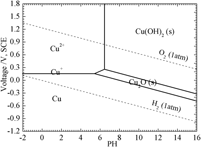Crossref Citations
This article has been cited by the following publications. This list is generated based on data provided by
Crossref.
Mahajan, Amit
and
Sidhu, Sarabjeet Singh
2019.
In vitro corrosion and hemocompatibility evaluation of electrical discharge treated cobalt–chromium implant.
Journal of Materials Research,
Vol. 34,
Issue. 08,
p.
1363.
Yang, Biaobiao
Shi, Chenying
Teng, Jianwei
Lei, Qian
Nie, Yan
and
Li, Yunping
2019.
Influence of Co addition on the deformation behavior and mechanical properties of Ni–16Cr–11Mo–2Cu alloy.
Materials Science and Engineering: A,
Vol. 767,
Issue. ,
p.
138442.
Yang, Biaobiao
Hou, Yuhang
Lei, Qian
Li, Yunping
and
Chiba, Akihiko
2020.
Influence of Cu addition on corrosion behavior and tensile performance of Ni-30Co-16Cr-15Mo-6Fe alloy.
Materials Characterization,
Vol. 161,
Issue. ,
p.
110140.
Yang, Biaobiao
Hou, Yuhang
Li, Yunping
and
Chiba, Akihiko
2020.
Roles of Mo and Cu on Electrochemical Behaviors of Ni-Base Alloys in Hydrofluoric Acid Solution.
Journal of The Electrochemical Society,
Vol. 167,
Issue. 10,
p.
101502.
Mahajan, Amit
Devgan, Sandeep
and
Sidhu, Sarabjeet Singh
2021.
Surface alteration of biomedical alloys by electrical discharge treatment for enhancing the electrochemical corrosion, tribological and biological performances.
Surface and Coatings Technology,
Vol. 405,
Issue. ,
p.
126583.
Korolev, Ivan
Yliniemi, Kirsi
Lindgren, Mari
Carpén, Leena
and
Lundström, Mari
2021.
Performance-Based Selection of the Cathode Material for the Electrodeposition-Redox Replacement Process of Gold Recovery from Chloride Solutions.
Metallurgical and Materials Transactions B,
Vol. 52,
Issue. 5,
p.
3107.
Mediukh, Roman
Mediukh, Vira
Labunets, Vasyl
Nosko, Pavlo
Bashta, Oleksandr
and
Kondratenko, Irina
2022.
Investigation of Structure Formation and Tribotechnical Properties of Steel Plasma Coatings After Chemical-Heat Treatment and Liquid-Phase Impregnation.
Acta Mechanica et Automatica,
Vol. 16,
Issue. 4,
p.
382.
Shima, Haruka
Mori, Manami
Yamanaka, Kenta
Yoshida, Kazuo
Yamazaki, Toshihiro
and
Chiba, Akihiko
2022.
Superior hardness–corrosion-resistance combination in a Co-, Cu-modified Ni–Cr–Mo alloy via multiple nanoscale segregation mechanisms.
Scripta Materialia,
Vol. 209,
Issue. ,
p.
114389.
Shuang, S.
Lyu, G.J.
Chung, D.
Wang, X.Z.
Gao, X.
Mao, H.H.
Li, W.P.
He, Q.F.
Guo, B.S.
Zhong, X.Y.
Wang, Y.J.
and
Yang, Y.
2023.
Unusually high corrosion resistance in Mo CrNiCo medium entropy alloy enhanced by acidity in aqueous solution.
Journal of Materials Science & Technology,
Vol. 139,
Issue. ,
p.
59.
Mahajan, Amit
Devgan, Sandeep
and
Kalyanasundaram, Dinesh
2023.
Surface alteration of Cobalt-Chromium and duplex stainless steel alloys for biomedical applications: a concise review.
Materials and Manufacturing Processes,
Vol. 38,
Issue. 3,
p.
260.
Zarebidaki, Arman
and
Akbarpour, Mehdi
2024.
Corrosion and wear behavior of electroless Ni-P-Cu coatings containing 8 and 18 wt% Cu.
Surface and Coatings Technology,
Vol. 492,
Issue. ,
p.
131228.
Li, Chao
Zhang, Ping
Yang, Biaobiao
and
Li, Yunping
2024.
Effect of carbon content on the corrosion behavior of Ni-Co-Cr-Mo-Cu alloys in both sulfuric and hydrochloric acids.
Materials Characterization,
Vol. 215,
Issue. ,
p.
114200.
Li, Chao
Zeng, Ziming
Teng, Jianwei
Yang, Biaobiao
and
Li, Yunping
2024.
Tribocorrosion Behavior of NiCoCrMoCu Alloys Containing Different Carbides in Acidic Media at Various Applied Loads and Sliding Speeds.
Materials,
Vol. 17,
Issue. 12,
p.
2971.
Li, Chao
Teng, Jianwei
Yang, Biaobiao
Ye, Xianjue
and
Li, Yunping
2024.
Effect of Carbon Content on Wear Behavior of Ni-Co-Cr-Mo-Cu Alloy.
Journal of Materials Engineering and Performance,
Vol. 33,
Issue. 10,
p.
5085.
Li, Chao
Yang, Biaobiao
Ye, Xianjue
and
Li, Yunping
2024.
The Role of Manufacturing Techniques in Reciprocating Wear of Carbide-Reinforced Ni-Co-Cr-Mo-Cu Alloys.
Journal of Materials Engineering and Performance,
Vol. 33,
Issue. 24,
p.
13870.
